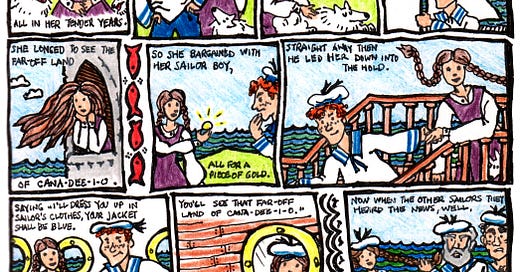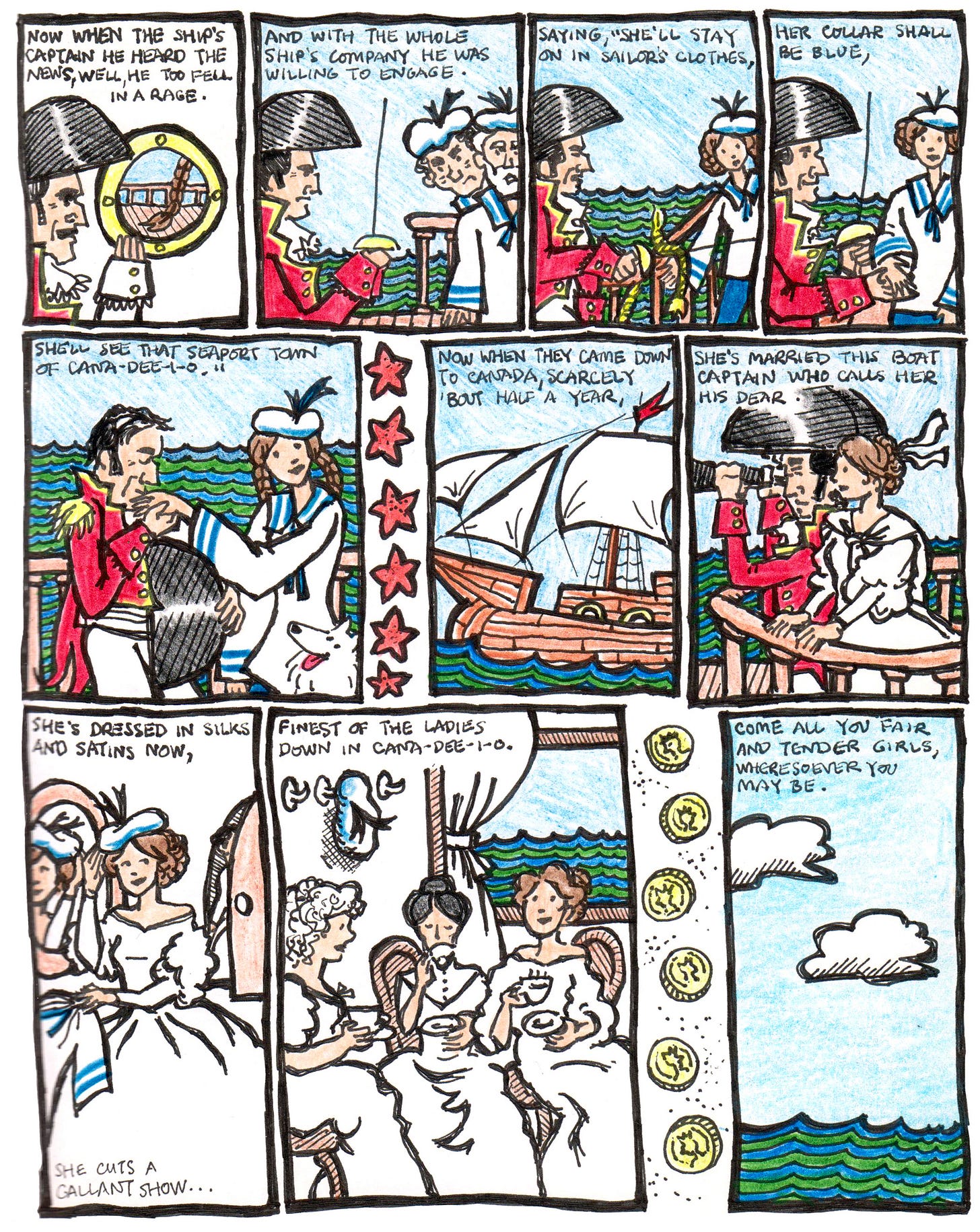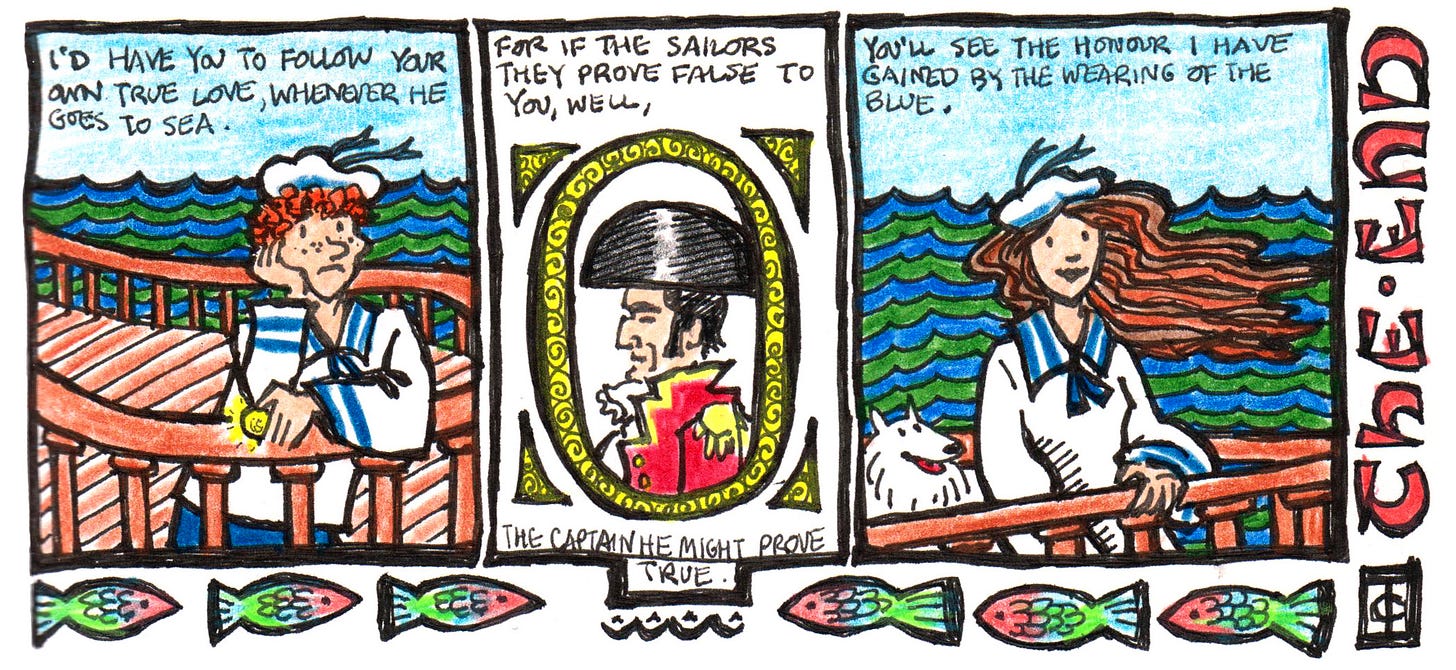This time, instead of a comic about a Bob Dylan tour adventure, here’s a comic (and some thoughts) about one of his songs.
In 1990, Bob Dylan recorded the album “Good As I Been To You,” a collection of traditional folk songs. He sang them all to the accompaniment of his own solo acoustic guitar. I first heard these songs when I was getting into Dylan’s music in the mid-90s, and it’s remained one of my favourite Dylan albums. I love the simplicity of the arrangements, the beautiful guitar playing, Dylan’s gravelly voice as it rolls and flows all around the lyrics… and I love the song Canadee-I-O. (Have a listen!)
A long time ago (in the 90s), I illustrated this song (on a bumpy train ride… apologies for my messy writing. You can also read the lyrics of Canadee-I-O here, on Bob Dylan’s site).
I drew myself as the main character. After all, I live in Canadee-I-O! Back when I drew these pictures, I had long brown hair, and I had two big white dogs, a smart adventurous one and a shy one, who seem to have found their way into the pictures.
She fell in love with a sailor boy…
I’ve always thought that she didn’t really love that sailor boy. Just listen to the line, “it’s true, she loved him well.” It sounds to me like a case of “The lady doth protest too much.” If she really loved him, we wouldn’t need that reassurance… we’d just know. (Is the singer trying to convince us, the listeners? Or is that the voice of the woman trying to convince herself?) Either way, if it had been true love, she certainly wouldn’t have had to “bargain” with him, and PAY him, to get him to take her along. No, it wasn’t the sailor boy she loved - it was the adventure of going to Canadee-I-O. Besides, what happens to the sailor boy when his girlfriend is threatened by all the ship’s company? We don’t hear about him standing up for her. He just vanishes from the song. He was only ever a means to an end. Now, the captain is more interesting…
Now when the Captain he heard the news…
The captain in my comic is more than a little inspired by Ciaran Hinds’ depiction of Captain Frederick Wentworth in the 1995 movie Persuasion (a movie I loved when it came out, and which I’m still crazy about). The captain in Persuasion is the hero of the story - the one who comes to the heroine’s rescue. So what happens with the captain in Canadee-I-O? He, too, falls for the girl and comes to her rescue. (Maybe not in that order.) And speaking of reversing order, I love the way the same line is used twice, each time with a different meaning. “And with the whole ship’s company, they were willing to engage” is used first to denote the crew’s anger at the stowaway woman, but afterwards, the same line (“And with the whole ship’s company, he was willing to engage”) is used to denote the captain standing up against his crew. That’s some real economy of language in a song that’s already pretty sparse with its words.
Anyway, here’s the big question: did she really love the captain? I have my doubts. She already used one sailor to get her to the place she wanted to go. What would stop her from using another one? Maybe this seems a bit cynical, but in the time we’re talking about (the song was written in the mid-1800s!), what other means did women have, to travel to new places they were dreaming of, other than taking advantage of some man’s convenient position? But even if her liaison with the captain was, for her, a marriage of convenience, it still sounds like she did well by it - she got where she wanted to go, and ended up with a husband who seems like a honourable person. And who knows, maybe she found love as well. I hold that hope for her.
In my illustrations, the captain’s wife keeps her sailor’s suit hidden, but leaves the hat hanging from a hook when the other fine ladies (who I never got around to colouring in) come to call. And she keeps her adventurous dog as well.
I wonder about the vanished sailor boy - if he knew what he’d lost, or if he just went on to the next adventure, never thinking about the one that got away.
Come all you fair and tender girls…
In the last verse, the narrative shifts, and the speaker is speaking in her own voice! It’s no longer just a tale about a fair and handsome girl - she’s now telling her own story. She’s truly empowered now, speaking from her safe position as a captain’s wife, and advising other “fair and tender girls” to follow their dreams as she has done herself. When she advises them to “follow your own true love,” I think she could be talking about a love of ambition or adventure, not necessarily a man. It may be that this was the only language available to a woman of that time - it wouldn’t have been possible for her to advise them to follow a career or a voyage of adventure. But when she sings about “the honour she has gained” in the last words of her narrative, she’s not talking about the honour she has gained as a captain’s wife who is now the “finest of the ladies” - it’s the honour she has gained “by the wearing of the blue.” It seems that she considers her seafaring adventures to be her greatest accomplishment. I just hope that, now that she’s married to the captain, she gets lots of opportunities for more ocean voyages.
I love that Dylan chose this song - the song of a woman we don’t fully get to know, but whom we can admire for setting her sights on her dream, and getting there. In my mind, she’s one of the stronger women in Dylan’s songs, which so often focus on the (presumably male) narrator/singer’s perspective, instead of on the (presumably female) characters in the songs. The women are often the objects of the narrator’s desire, rather than the main characters of their own stories. What made Dylan choose to sing and record this song? I wish I knew! I’m just glad he did.
You can check out my previous Bob Dylan comics here, or stay tuned for the next installment, when I recount the tale of my long-ago trip to see Bob in Hamburg!







